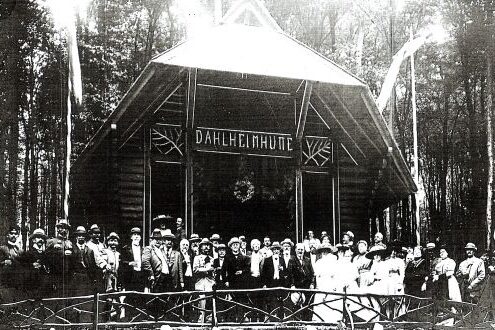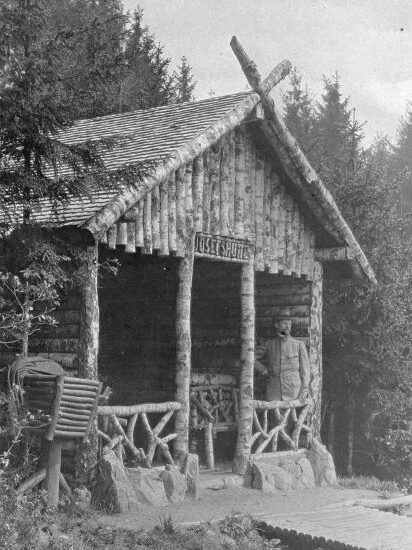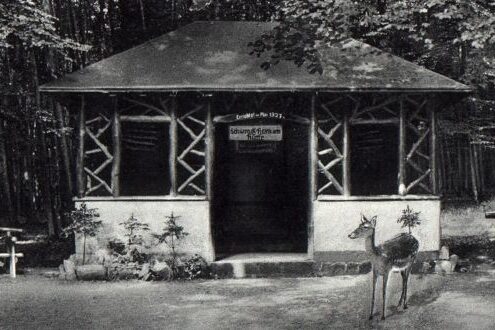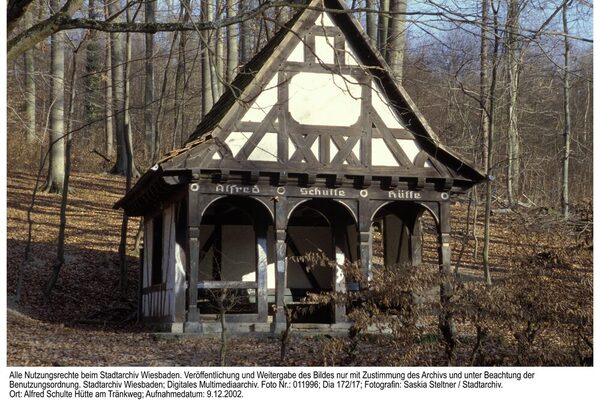Refuges
Since the middle of the 19th century, numerous mountain huts have been built in Wiesbaden's city forest. The oldest building still standing today is the "Ludwig-Schwenck-Hütte" near the Grauer Stein.
When Wiesbaden began to develop into a world-class spa town around the middle of the 19th century, it became necessary to make the stay of spa guests and locals in the city and the surrounding area as pleasant as possible. Thanks to the commitment of the Wiesbaden Beautification Association, founded in 1856, parts of the city forest were transformed into a landscape park with the help of tree planting, artificial watercourses and waterfalls, the development of springs and groups of rocks. Paths, benches, shelters for hikers and observation towers were gradually built.
In 1857, the Verschönerungsverein built the first refuge hut on the Neroberg, which was followed by numerous others, also by other associations. These included the Ludwig-Schwenck-Hütte, the Pauline-Scholz-Hütte, the Josefshütte, the Dalheim-Hütte, the Adolf-Weygandt-Hütte, the Boglerhütte and the Carl-Hensel-Hütte. As late as 1913, the Verschönerungsverein had iron plaques with the corresponding names and dedications put up in all the huts.
With the outbreak of the First World War in 1914, construction work came to a standstill. Many huts were even illegally dismantled and burned during the war. In the period after the First World War, the economic and political situation - Wiesbaden was occupied from 1918 to 1930 - meant that hardly any new huts could be built. Only the Schwenck-Herrmann-Hütte, the Rudolf-Dietz-Hütte and the Curt-Hoffmann-Hütte were built during this period.
It was only during the Nazi era that more new huts were built in the city forest, such as the Karl Scheuermann hut, the Luja hut, the Wilhelm Bausch hut, the Alfred Schulte hut and the Wilhelm von Opel hut. The Second World War again led to destruction and damage. In the following years, a strong wave of renovation and new construction took place with a "standardized type", which still makes up the majority of the huts in Wiesbaden's forests today. In the 1980s, the Kur- und Verkehrsverein (KVV) also began to focus more on the construction of new shelters and had two new wooden buildings erected: the Pagenstecherhütte on Schützenhausweg and the Pagenstecherhütte (1983) on Hohe Wurzel.
As the huts are (more or less elaborately designed) wooden structures, which have a limited lifespan due to lack of maintenance and vandalism, there are no huts from the 19th century left in the city forest today. But many of the huts from the first half of the 20th century have also disappeared in recent years. The network of existing huts still fulfills its function today and offers numerous hikers shelter in bad weather and the opportunity to rest.
Ludwig-Schwenck hut
Located in the Frauenstein district, not far from the Grauer Stein, the shelter from 1907 is the oldest preserved shelter in the forests around Wiesbaden. It was built four years after the death of board member Ludwig Schwenck by the Rhein-und Taunus-Klub Wiesbaden in his honor and was inaugurated on 21 June 1907. The architect was Carl R. Schiemann. In contrast to the previously built shelters, which were usually made of logs, boards and branches, this was the first time that the Nordic log cabin type was used. However, the amount of wood required is very high - around seven cubic meters of wood were needed for the construction - and the costs are correspondingly high. The Ludwig-Schwenck-Hütte cost just over 1,000 marks, a very high sum for the time. However, the lifespan of such a construction was much longer.
The merchant Ludwig Schwenck (1843-1903) was the founder of the company "L. Schwenck, Strumpf- und Trikotagen- Handlung", located in Mühlgasse, and was also the secretary of the Wiesbaden Beautification Association for many years. On the name plaque in the hut, the surname is incorrectly written without a "c".
Pauline-Scholz-Hut
The small building on Fasanerieweg, also known as the Paulinenhütte, was erected by the Wiesbaden Beautification Association in 1909. The association had received a donation of 5,000 Reichsmark from Wiesbaden citizen Pauline Scholz (1836 or 1838-1908) in her will. The hut has neither the character of a forest house through the use of brown wood colors or decorative branches, nor hints of a rural property, e.g. through its half-timbered construction. It is more reminiscent of a pavilion or a children's playhouse in a garden. In 1952, the hut, which had been damaged during the Second World War, was refurbished by the Wiesbaden Kur- und Verkehrsverein. Thanks to the financial support of the North-East Local Advisory Council, the hut was completely renovated in 2009 and reopened on June 20 of the same year.
Josefshütte
Formerly located on Kisselbornweg, south-east of the old Platter Straße, the hut was built by the Wiesbaden Beautification Association and was donated by its first chairman Josef R. A. Hupfeld (1851-1923). Hupfeld was the founder of the iron, metal and building materials wholesaler originally located in Gartenfeldstraße. The inauguration of the ironworks was celebrated on Hupfeld's 60th birthday, October 9, 1911. In 1952, the Kur- und Verkehrsverein had the Josefshütte restored and renovated in 1990 for 2,500 DM. Unfortunately, the hut was completely destroyed in a storm in the 1990s and never rebuilt.
Dahlheim hut
The Dahlheim hut, located on the Kaiser-Wilhelm-Weg to the Schläferskopf, was inaugurated on July 15, 1912. The reason for building the hut was Wilhelm Dahlheim (1837-1917), who was caught in a storm at this location in 1911 and had nowhere to take shelter. Dahlheim, a member of the board of the Wiesbaden Beautification Association, donated a large part of the funds for the construction of the hut to the association on the occasion of his 75th birthday. The design was created by the painter Carl Jacob Frankenbach. Thanks to generous support from the Dotzheim local council (in whose district the hut is located), the Kur- und Verkehrsverein and other donors, the hut was completely renovated in 2009.
Adolf Weygandt Hut
The shelter located at the north-eastern end of the Rabengrund, not far from the "Höfchen" Roman estate, was erected in 1912 by the Wiesbaden Beautification Association and only referred to as the "Halle am großen Rundfahrweg". Due to its size, the 1912 building, which is more accurately described as a shelter, had a predecessor built in 1892. In 1926, the hut was given the name Adolf-Weygandt-Hütte in honor of the long-time second chairman of the Verschönerungsverein. The Wiesbaden merchant Heinrich Adolf Weygandt (1853-1926), founder of the hardware store of the same name, was a board member of the Rhein- und Taunus-Klub, the Verschönerungsverein Wiesbaden and the Bezirksverein Altstadt (district associations). After the damage suffered during the Second World War, the Kur- und Verkehrsverein restored the half-timbered building in 1952.
Boglerhütte
Formerly located above the fish farm, the Karlshütte or Boglerhütte was donated by the London merchant and Wiesbaden native Karl Bogler (1846-1923). It was built according to a design by the well-known Wiesbaden painter Kaspar Kögler and the architect Friedrich Hatzmann under the direction of the Wiesbaden Beautification Association. The inauguration of the wooden hut was celebrated on July 5, 1913. In 1952, the Kur- und Verkehrsverein had it refurbished. As there was no money for a necessary fundamental renovation, the KVV had the culturally and historically significant hut demolished in 2006. Today, only the foundations remain as a reminder of its construction.
Carl Hensel Hut
Formerly located on the Speierskopf in the rear Nero Valley, the hut was built by the Wiesbaden Beautification Association with funds from the testamentary foundation of Carl Hensel (1828-1914), a Wiesbaden bookseller. The design by the painter Carl Jacob Frankenbach and the architect Friedrich Hatzmann was carried out by the companies Carstens, Hassler and May, and the inauguration was celebrated on November 10, 1914. After the Second World War, the hut was renovated once again by the Kur- und Verkehrsverein in 1952. Today, the hut, built in the Lower Saxon-Westphalian half-timbered style, no longer exists.
Schwenck-Herrmann hut
Located on Herreneichenweg, north of the Leichtweißhöhle, and inaugurated on June 22, 1927, the hut is the first new creation of the Wiesbaden Beautification Association after the First World War. It had a predecessor from 1900. In 1952, it was refurbished by the Kur- und Verkehrsverein. On November 17, 2007, the hut was reopened after the basic dog training group of the Wiesbaden Hunting Association thankfully took on the renovation of the hut; among other things, a new, more durable roof was put on. The hut was named after the two board members of the Wiesbaden Beautification Association, the merchant and long-time treasurer Hans Herrmann and the gentleman tailor and long-time secretary of the association Carl Schwenck. Due to the preserved murals on the brick rear wall, the half-timbered building is unique in Wiesbaden.
Rudolf Dietz Hut
In 1928, the Friends of Nature Naurod had the Rudolf-Dietz-Born erected on the eastern slope of the Kellerskopf in honor of their fellow citizen. As the fountain quickly became a popular hiking destination and resting place, two years later a shelter made of logs, branches and boards was built in the immediate vicinity. It was named after the nationally renowned Naurode dialect poet Rudolf Dietz. As some of his poems are considered anti-Semitic and Dietz had been a member of the NSDAP since April 1933, his person is viewed critically today. The picturesque ensemble of fountains and the picturesque refuge crowned with a weather vane is still a popular destination for excursions today.
Curt Hoffmann Hut
Located on Philosophenweg, on the western slope of the Neroberg, the hut was built in 1931 by the Wiesbaden Beautification Association with funds from Dr. Curt Hoffmann (1862-1947). It originally resembled the Schwenck-Herrmann hut. Following damage during the Second World War and the post-war period, the Kur- und Verkehrsverein had the hut rebuilt in a simplified form (without the brick rear wall) in 1952.
The founder of the refuge, Curt Hoffmann, was, among other things, court pharmacist to the Grand Duke of Baden and had been chairman of the Wiesbaden Beautification Association since 1923. After the forced merger with the Wiesbadener Kur- und Verkehrsverein (1938), the latter made him an honorary member.
Karl Scheuermann Hut
The shelter, also known as the "Scheuermann-Germanenhütte", was located on the Rheingauerpfad, below the former popular excursion restaurant "Knusperhäuschen". This path owes its existence to the road construction expert and Wiesbaden city planning officer Dr. Karl Scheuermann (1869-1935). The hut was built in Scheuermann's honor by the Wiesbaden Beautification Association at a once picturesque location (to the south, one could once look across a meadow valley to the Rhine). The shelter, which originally had a thatched roof and was built in the style of a "Germanic hut", was inaugurated on 4.11.1934. It was damaged by bombs during the war and the Kur- und Verkehrsverein had the hut restored in 1952. Due to its poor condition and the expected high renovation costs, the listed hut was quickly demolished in 2010.
Luja hut
The hut, which is located on Weißer Weg in the Dotzheim district and is made of simple logs and boards, was built in 1934 by the Wiesbaden-Dotzheim Beautification and Nature Conservation Association and named after the Dotzheim pastor Luja in memory of his importance to the village. Johann Christian Reinhard Luja was not only a pastor, but also a historian. His work paved the way for the Verein für Nassauische Altertumskunde und Geschichtsforschung, of which he was one of the founders in 1811/12. Although the hut is less elaborately designed than others, the use and processing of wood as a building material with its natural unevenness emphasizes the character of a forest hut.
Wilhelm Bausch Hut
The refuge, located at the south-eastern foot of the Kellerskopf, was not built until the 1970s and not in 1934, as stated on the sign on the hut. It was built by the Naurod Friends of Nature Association, which was founded in 1927. The hut to which the date refers was initially built by the association in 1934 on the Erbsenacker, roughly where the children's playground is today. However, it is said to have been destroyed by American soldiers towards the end of the war. In the 1970s, the association decided to build a new hut from logs and boards. As the Erbsenacker was designated as a building area around this time, the hut site was moved from the Erbsenacker to the Kellerskopf. In a joint effort, a new hut was built closely based on the previous building. Even the year of construction, 1934, was added. As Wilhelm Bausch, co-founder of Naturfreunde Naurod, was also instrumental in the construction of this hut, the people of Naurod decided to name it the Wilhelm Bausch Hut in his honor. Renovations were carried out in 1984-86 and 1993/94.
Alfred Schulte Hut
The shelter built in the Dambach Valley, in the immediate vicinity of the Tränkweg, by the Wiesbaden Beautification Association was inaugurated on June 6, 1937. It is named in honor of Alfred Schulte, the outgoing mayor of Wiesbaden at the time. The construction of the half-timbered building, reminiscent of a village smithy, was carried out by the Heinz Hildner construction studio at a cost of 3252.36 RM. After being damaged during the Second World War, the hut was reopened by the Kur- und Verkehrsverein in 1951.
Wilhelm von Opel hut
Located on the Teufelsgraben, northwest of the Leichtweiß cave, the hut was donated by his son, Dr. Wilhelm von Opel, to mark the 100th birthday of Adam Opel (1837-1895), the founder of the Opel works in Rüsselsheim. Begun in 1937 and completed in 1938, it is the last hut to be erected by the Wiesbaden Beautification Association, of which Wilhelm von Opel was an honorary member. The association had to dissolve itself in January 1938 by order of the National Socialist rulers and was merged with the Kurverein. The half-timbered building, originally covered with slate, has brick-lined compartments and is more reminiscent of a house than a refuge. After the war damage was repaired by the Kur- und Verkehrsverein, it was reopened in 1951. On November 17, 2007, the hut, which had been badly damaged by a fallen tree at the beginning of the year, was reopened thanks to the financial support of the North-East Local Advisory Council. The gable and roof were modified.
Literature
- Landesamt für Denkmalpflege (Hrsg.)
Monument topography of the Federal Republic of Germany. Cultural monuments in Hesse. Wiesbaden II - The villa areas, edited by Sigrid Russ, Braunschweig/Wiesbaden 1988 (p. 257).
- Ludwig, Rudolf
Friends of Nature Naurod 1927 e. V. In: 650 Jahre Naurod: 1346-1996. Nauroder Chronik bis zur Gegenwart. Festauschuß Naurod and Wolfgang Nickel (ed.), Wiesbaden-Erbenheim 1995 (p. 141).
- Reiß, Thorsten
In: Wiesbaden yesterday - today - tomorrow No. 5, Wiesbaden 2005 (pp. 29-30).
- Baumgart, Gretel; Funk, Birgit und Reiß, Thorsten
The Dahlheim hut. In: Wiesbaden yesterday - today - tomorrow No. 7, Wiesbaden 2007 (pp. 23-24).
- Reiß, Thorsten
Refurbishment of two refuges. In: Wiesbaden yesterday - today - tomorrow No. 7, Wiesbaden 2007 (p. 26).



